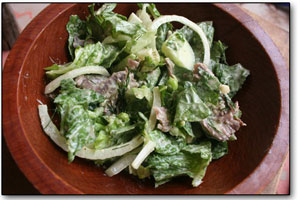
The cream of the salad crop
“We’re creamy,” said Luci Brieger, a vegetable farmer, when I asked how she and her family were doing. “We’re having a creamy summer.”
She said this knowing I’d called to discuss her salad dressing, which goes by the name “Creamy.” It was also understood that we were talking about something larger. On that Victor, Mont., farm, cream is a unit of goodness.
 Despite what its name suggests, Creamy contains no milk products. It began years ago as a modified Caesar dressing, and that vibe remains to this day in the romaine-based salad it most frequently adorns.
Despite what its name suggests, Creamy contains no milk products. It began years ago as a modified Caesar dressing, and that vibe remains to this day in the romaine-based salad it most frequently adorns.
But more than simply a salad dressing, Creamy is something of a mother sauce, akin to what hollandaise would be in a French kitchen. There are many uses for Creamy besides upon salad, and many versions of Creamy.
The Brieger kitchen runs with a brutal efficiency. Children are plucked from their games and put to work as garlic peelers and pea shellers. There is a constant game of cat-and-mouse going on between Luci and the parade of kids, parents, farm help, visitors and other “random people” who, if the coast is clear, will cross the kitchen, open the fridge, and scan for Creamy.
“When they see leftover Creamy in the fridge, they put in on bread or other stuff, or dip stuff in it,” Brieger said. “I frown on that.”
Creamy
2-4 cloves fresh garlic, mashed with ½ teaspoon salt. Brieger recommends a two-piece garlic smasher with spikes inside that you rotate between your palms.
¼ cup lemon juice or white vinegar
2 tsp grated lemon zest
½ teaspoon dry mustard powder
½ teaspoon Worcestershire sauce
½ cup mayo (or Vegenaise, which Brieger and I prefer)
olive oil, as needed
Combine ingredients with a fork and add oil until the sauce reaches “the texture that pleases me,” as Brieger explained. Think ranch dressing. Season with salt.
The amount of Creamy made by the above quantities will dress a salad of one large head of romaine (chopped), one medium cucumber (sliced), half a medium-sized sweet onion (sliced) and a half cup fresh dill, chopped. Mix these ingredients and toss in Creamy. Portion onto plates, grind black pepper to taste on each portion, and serve.
The variations on Creamy are many. One of Brieger’s favorites is Basil-flavored Creamy. For this version, omit the mustard, Worcestershire sauce and white vinegar, and replace with a handful or two of basil leaves.
Brieger says that one of the high points of summer is a pea and mutton salad they make, as soon as the peas are ready to shell. “It’s the reason I grow shelling peas,” she admits.
I approach the topic of meat salad with caution. I’ve seen enough restaurant salads that focus on rich adornments – shrimp, turkey slices, pieces of cheese, beef or salmon – rather than veggies. These heavy toppings sit on the leaves like walruses on a flock of songbirds. As the squashed leaves are left behind, the eater will nonetheless bask in the proud glow of having eaten a salad.
Brieger’s pea and lamb salad, by contrast, is highly balanced, to the point where the ingredients need each other, and that chewing only meat, without lettuce, peas, onions and cucumber in one’s mouth as well, wouldn’t be enough.
This salad is built upon Brieger’s usual salad of chopped romaine, dill and sliced onions and cucumbers. It also includes shelled peas and braised lamb, and is held together by a spicy version of Creamy that’s tweaked to balance the gaminess of a strong meat like lamb. When Brieger makes it, she uses mutton, which is all but guaranteed to be tough and gamey.
The tougher the meat, the better, provided you planned far enough ahead to cook it soft. Braised slowly for hours, the connective tissue that crisscrosses tough cuts of meat melt. The most commonly available tough cut of lamb is shank, but shoulder, or any cut from an older sheep, can be used as well.
Brown the meat for a few minutes, about 6 inches under the broiler, in a baking dish or cast-iron pan, stirring or turning frequently to prevent the brown from becoming a burn. When browned, drop the oven heat to 300, and add a mixture of wine and water – enough to barely cover the meat. Add a bay leaf, sprinkles of salt and garlic powder, and cook at 300, covered, checking frequently, until it softens – about 3 hours for shank. As it cooks, add additional liquid as necessary to keep the meat about half-submerged, tasting the broth each time, turning the meat, and adding another sprinkle of salt if necessary. Cook until the meat is soft enough to cut with a spoon, and let it cool to room temperature.
When cool, pull the meat apart with your fingers, removing any bones and fat, until its in chunks of roughly an inch.
Modified Creamy for Lamb
2/3 cup mayo
1/3 cup yogurt
3-6 cloves of shredded garlic
1 tablespoon horseradish
1 teaspoon curry powder
¼ cup grated sharp cheddar cheese
½ teaspoon of salt
½ teaspoon of black pepper
Prepare the same way as creamy. This will dress a salad of one large head romaine (chopped), one medium cucumber (sliced), and half of a medium-sized onion (sliced), a half-cup of chopped fresh dill, a half-pound of shelled peas, and a pound of braised sheep.
Combine all salad ingredients except for the romaine with the modified Creamy. Then toss in the chopped lettuce. Serve on a long, creamy summer’s eve.
